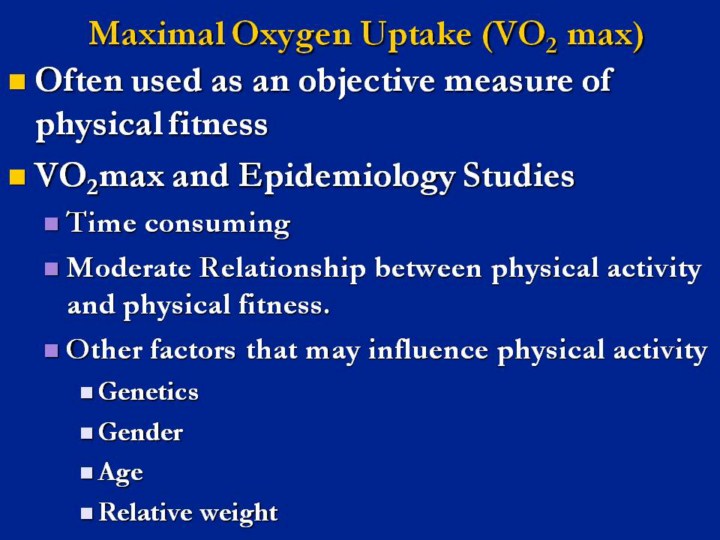| front |1 |2 |3 |4 |5 |6 |7 |8 |9 |10 |11 |12 |13 |14 |15 |16 |17 |18 |19 |20 |21 |22 |23 |24 |25 |26 |27 |28 |29 |30 |31 |32 |33 |34 |35 |review |
 |
Because physical activity is difficult to measure, Maximal Oxygen Uptake or VO2 max is often used as a proxy measure of physical activity. However, VO2 max is actually a measure of physical fitness, not physical activity. Those who are more active and expend more energy tend to have higher fitness levels. Many VO2 max protocols are time consuming and may not be possible in large epidemiological studies where there are great number of participants. In addition, when examining population studies, there is only a moderate relationship between physical activity and physical fitness (Siconolfi, 1985; Jacobs, 1993). This lack of a strong relationship could be due to the fact that there are other factors besides activity, such as genetics (Bouchard, 1988), gender, age, and relative weight (Leon, 1981) that influence physical activity.
Recommended Readings: Siconolfi SF, Lasater TM, Snow RCK, Carleton RA (1985). Self-reported physical activity compared with maximal oxygen uptake. American Journal of Epidemiology; 122: 101-105.
Jacobs DR, Ainsworth BE, Hartman TJ, Leon AS (1993). A simultaneous evaluation of 10 commonly used physical activity questionnaires. Medicine and Science in Sport and Exercise; 25: 81-91.
Bouchard C, Boulay MR, Simoneau JA, Lortie G, Perusse L (1988). Heredity and trainability of aerobic and anaerobic performance: an update. Sports Medicine; 5: 69-73.
Leon AS, Jacobs DR, DeBacker G, Taylor HL (1981). Relationship of physical characteristics and life habits to treadmill exercise capacity. American Journal of Epidemiology; 113: 653-660.
American College of Sports Medicine (2000). ACSM’s guidelines for exercise testing and prescription (6th ed.). Baltimore, MD: Lippincott Williams & Wilkins. |